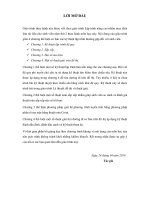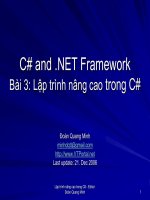OBJECT ORIENTED PROGRAMMING (lập TRÌNH NÂNG CAO SLIDE)
Bạn đang xem bản rút gọn của tài liệu. Xem và tải ngay bản đầy đủ của tài liệu tại đây (824.81 KB, 155 trang )
ADVANCED PROGRAMMING
OBJECT ORIENTED
PROGRAMMING
CLASSES AND OBJECT
Outline
Working with Classes and Objects
Defining Classes
Creating Objects
Writing and Invoking Constructors
Using Methods
Defining a Method
The Static Methods and Variables
Methods with a Variable Number of
Parameters
JavaBeans Naming Standard for Methods
Method Overriding and Overloading
Khoa CNTT – ĐH Nông Lâm TP. HCM 01/2007
2/155
Outline
Inheritance
Abstract Classes
Writing and Using Interfaces
Object-Oriented Relationships
The is-a Relationship
The has-a Relationship
Polymorphism
Conversion of Data Types
Understanding Garbage Collection
Khoa CNTT – ĐH Nông Lâm TP. HCM 01/2007
3/155
Programming?
OOP
–
–
Student
Class
Map your problem in the real - studentNo
- courseId
name
world: Real world objects and -- birthday
- lecturer
+ serLecturer()
actions match program objects + enroll()
+ getStudents()
…
and actions
Define “things” (objects)
which can do something
Create a “type” (class) for these objects so that you don’t
have to redo all the work in defining an objects properties
and behavior
An OO program: “a bunch of objects telling each other
what to do by sending messages”. (Smalltalk)
A strong reflection of software engineering
Abstract data types
Information hiding (encapsulation)
Khoa CNTT – ĐH Nông Lâm TP. HCM 01/2007
4/155
Goals of Object Technology
To create a software:
– Robustness: capable of handling
unexpected inputs that are not
explicitly defined for its application.
– Adaptability: evolve over time in
response to changing conditions in its
environment.
– Reusability: the same code should be
usable as a component of different
systems in various applications.
Khoa CNTT – ĐH Nông Lâm TP. HCM 01/2007
5/155
Important OO concepts
Abstraction
Encapsulation
Objects & Class
Object state and behavior
"P.I.E
triangle
Object identity
Abstraction
Messages
Inheritance
Polymorphism
Encapsulation
Information/implementation hiding
Inheritance
Polymorphism
Khoa CNTT – ĐH Nông Lâm TP. HCM 01/2007
6/155
Benefits of Object Technology
1) Faster application development at a lower
cost
2) Decreased maintenance time
3) Less complicated and faster customization
4) Higher quality code
Khoa CNTT – ĐH Nông Lâm TP. HCM 01/2007
7/155
Objects
Objects are:
Are building blocks for systems
Contain data that can be used or modified
Bundle of variables and related methods
An object possesses:
Identity: Định danh
State: Trạng thái
What the object remembers
Interface: Giao tiếp
A means of distinguishing it from other objects
Messages the object responds to
Behavior: Ứng xử
What the object can do
Student
- studentNo
- name
- birthday
+ getName()
+ enroll()
Khoa CNTT – ĐH Nông Lâm TP. HCM 01/2007
8/155
Object Example
The car shown in the figure can be considered an
object.
It has an ID ("1"),
state (its color, for instance, and other
characteristics),
an interface (a steering wheel and brakes, for
example)
and behavior (the way it responds when the steering
Many
texts regard an
wheel
is turned or
the brakes are applied).
object
as possessing
only
two characteristics –
state and behavior.
When considered this
way, identity is part of
the state, and the
interface is included in
the behavior.
Khoa CNTT – ĐH Nông Lâm TP. HCM 01/2007
9/155
Classes
A class
Objects of the same class are similar with respect
to:
Defines the characteristics and variables common
to all objects of that class
Interface
Behavior (method)
State
(variable)
Used to instantiate (create an instance of) specific
objects
Provide the ability of reusability
Car manufacturers use the same blueprint to build
many cars over and over
Khoa CNTT – ĐH Nông Lâm TP. HCM 01/2007
10/155
Class Example
The car at the top of the
figure represents a class
Notice that the ID and
color (and presumably
other state details) are
not known, but the
interface and behavior
are.
Below the "class" car are
two objects which
provide concrete
installations of the class
2
2
Khoa CNTT – ĐH Nông Lâm TP. HCM 01/2007
11/155
Working with Classes
The class is the basis for object-oriented
programming
The data and the operations on the data are
encapsulated in a class
A class is a template that contains the data
variables and the methods that operate on
those data variables following some logic
All the programming activity happens inside
classes
Khoa CNTT – ĐH Nông Lâm TP. HCM 01/2007
12/155
Working with Classes (cont.)
The data variables and the methods in a class
are called class members
Variables, which hold the data (or point to it in
case of reference variables), are said to
represent the state of an object
The methods constitute class’ behavior
Khoa CNTT – ĐH Nông Lâm TP. HCM 01/2007
13/155
Communication
Objects communicate via messages
Messages in Java correspond to method calls
(invocations)
Three components comprise a message:
1. The object to whom the message is addressed
(Your Car)
2. The name of the method to perform
(changeGears)
3. Any
parameters needed by the method
sender
target (lower
gear)
setSomething()
Khoa CNTT – ĐH Nông Lâm TP. HCM 01/2007
14/155
Object Messaging Example
By itself the car is
incapable of activity. The
car is only useful when it
is interacted with by
another object
Object 1 sends a message
to object 2 telling it to
perform a certain action
In other words, the driver
presses the car’s gas
pedal to accelerate.
+
Khoa CNTT – ĐH Nông Lâm TP. HCM 01/2007
15/155
Accessing State
State information can be accessed two ways:
Using messages:
Eliminates the dependence on implementation
Allows the developer to hide the details of the
underlying implementation
"Accessor" messages are usually used instead
of accessing state directly
Example: getSpeed() may simply access a state
value called "speed" or it could hide a calculation
to obtain the same value
Khoa CNTT – ĐH Nông Lâm TP. HCM 01/2007
16/155
Encapsulation
Encapsulation: to group related things
together, so as to use one name to refer
to the whole group.
–
–
Functions/procedures encapsulate
instructions
Objects encapsulate data and related
procedures
Khoa CNTT – ĐH Nông Lâm TP. HCM 01/2007
17/155
Information hiding
Information hiding: encapsulate to hide
internal implementation details from
outsiders
–
–
–
–
Outsiders see only interfaces
Programmers have the freedom in
implementing the details of a system.
The only constraint on the programmer is to
maintain the interface
public, private, and protected
Khoa CNTT – ĐH Nông Lâm TP. HCM 01/2007
18/155
Inheritance
Shape
+draw()
+erase()
+move()
+setColor()
+getColor()
“is-a” relations
The general classes can
be specialized to
more specific classes
Circle
Square
Triangle
+flipVertical()
+flipHorizontal()
Reuse of interfaces & implementation
Mechanism to allow derived classes to possess
attributes and operations of base class, as if
they were defined at the derived class
We can design generic services before
specialising them
Khoa CNTT – ĐH Nông Lâm TP. HCM 01/2007
19/155
Polymophism
Polymorphism:
–
–
Shape
Ability to assume
different forms or shapes.
To exist in more than
one form
Object polymorphism:
–
–
+draw()
+erase()
+move()
+setColor()
+getColor()
Circle
+draw()
+move()
Square
+draw()
+move()
Triangle
+draw()
+move()
Objects of different derived classes can be treated
as if they are of the same class – their common base
class
Objects of different classes understand the same
message in different ways
•
example: on receiving message draw(), Rectangle
and Triangle objects perform different draw()
methods
Khoa CNTT – ĐH Nông Lâm TP. HCM 01/2007
20/155
Java Class
Java Classes
Data
members
Method
public class Student {
private int age;
private String name;
private Date birthDate;
public int getAge() {
return age;
}
}
Class Student with data members and an instance
method (accessor)
Khoa CNTT – ĐH Nông Lâm TP. HCM 01/2007
22/155
Classes
Encapsulate attributes (fields) and behavior
(methods)
Attributes and behavior are members of the class
Members may belong to either of the following:
The whole class
Individual objects
Class variables and methods, indicated by the
keyword static
Instance variables and methods
Classes can be
Independent of each other
Related by inheritance (superclass / subclass)
Related by type (interface)
Khoa CNTT – ĐH Nông Lâm TP. HCM 01/2007
23/155
Working with Objects
Objects of pre-defined classes must be explicitly
created by new operator
– Allocate dynamic memory in heap memory
– A constructor will be called to initialize the newly
created object.
Objects are manipulated via references
Invoke object’s methods:
<object reference>.<method_name>(<arguments>)
public class StringTest {
public static void main(String args[]) {
String s1 = new String("Hello, ");
String s2 = s1.concat("world!");
System.out.println("Here is the greeting" +
s2);
}
}
Khoa CNTT – ĐH Nông Lâm TP. HCM 01/2007
24/155
Defining a Class
A class declaration specifies a type
–
–
Attributes:
–
object's instance variables
Methods:
–
The identifier: specifies the name of the class
Attributes, methods, and access control
tasks that the objects can do
Access modifiers:
–
–
–
–
public
public class
class BankAccount
BankAccount {{
private
private String
String ownerName;
ownerName;
private
private double
double balance;
balance;
public
public void
void getOwnerName()
getOwnerName()
{{
return
return ownerName;
ownerName;
}}
...
...
public : Accessible anywhere by anyone
protected : Accessible only to the class itself and to its
subclasses or other classes in the same “package”
private : Only accessible within the current class
default (no keyword): accessible within the current
package
Khoa CNTT – ĐH Nông Lâm TP. HCM 01/2007
25/155









